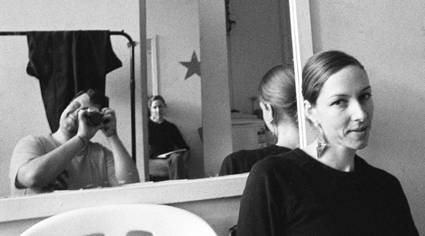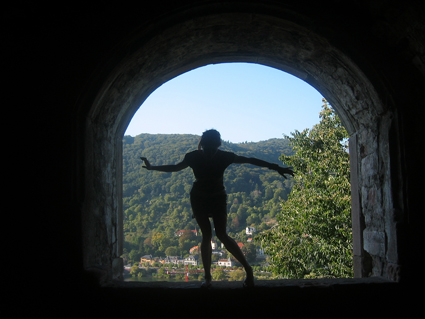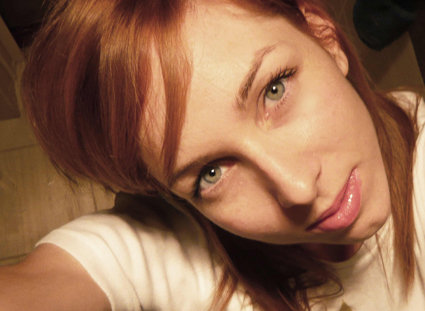tanja liedtke: in the accumulation of traces
justine shih pearson: life in movement

Tanja Liedtke & Julian Crotti, Life in Movement
photo Julian Crotti
Tanja Liedtke & Julian Crotti, Life in Movement
LIFE IN MOVEMENT IS A DOCUMENTARY DIRECTED BY BRYAN MASON AND SOPHIE HYDE ABOUT THE SHORT LIFE AND TRAGIC DEATH IN A ROAD ACCIDENT OF CHOREOGRAPHER/DANCER TANJA LIEDTKE, ON THE EVE OF TAKING UP THE DIRECTORSHIP OF SYDNEY DANCE COMPANY (OBITUARY, RT81).
Let’s get the accident out of the way, as the film does. In one of the filmmakers’ clever moves they place news coverage of Liedtke’s death up front, within the first few minutes, telling us that yes, it is a film about this event, but also signalling that it is not their story’s eventual revelation or end.
The tragedy of an exceptional and promising life cut short is clear, and this aspect of the documentary has been widely reviewed in the mainstream media in response to the film’s award-winning run through last year’s film festivals and subsequent cinema release. (Eleven official selections and awards are listed on the film’s website, including Sydney Film Festival’s Australian Documentary Prize and both jury and audience awards at Cinedans.) But beyond this narrative journey about the life and creative impulse of Liedtke herself, Life in Movement paints a portrait as much about a close group of friends and collaborators coming to terms with their loss.

Tanja Liedtke, Silhouette Falling (archival), Life in Movement Life
photo Solon Ulbrich
Tanja Liedtke, Silhouette Falling (archival), Life in Movement Life
Filmically, editor Bryan Mason deftly stitches together footage from a range of different sources, skipping back and forth in time and across formats and aspect ratios. There is material shot by him in rehearsal and performance of Liedtke’s two full-length dance works, Twelfth Floor and Construct, in anticipation of their individual premieres (Mason had been contracted by Liedtke to film both productions) and in remounted international tours after Liedtke’s death. There is an abundance of interviews with partner Solon Ulbrich, dancers Kristina Chan, Paul White, Anton, Amelia McQueen, Julian Crotti and Joshua Tyler; choreographers Garry Stewart and Lloyd Newson; and with close friends and family. And amazingly, there is a treasure trove of video material from Liedtke herself—old grainy snippets of her childhood antics at boarding school and, later, recordings of experimentation in hotel rooms or alone in the studio in early development of ideas that would find their way into Twelfth Floor and Construct.
These small sketches, gems of ideas torn from an artist’s undifferentiated ream of creative research collected along the way towards realising a final work, are a boon for the film. They allow for Liedtke to be strongly inserted into the film in a very intimate way, as she talks to camera and reaches for the record button. Mason and Hyde have, in the end, invited us to witness a vivisection of the creative process.

Tanja Liedtke, self portrait, Life in Movement
The film’s most interesting achievement is the way in which it understands the dramaturgy of Liedtke’s works, tracing particular scenes and choreographic moments back through the archive of video documentation. It is remarkable that Liedtke was such an avid user of video and thereby provided such an archive; but equally remarkable is the way in which the filmmakers select and use that material, re-deploying the dramaturgy to tell their own story. The final scene from Construct, in which Kristina Chan is enclosed and stilled within a tower of timber two-by-fours (used playfully throughout the work in varying configurations), is cut into a long sequence in which collaborators and family members talk about Liedtke’s high standards, her unreachable expectations for herself and her fears of failure. We accumulate an understanding of real life events through artistic ones and vice versa: the objects, the materials and tools for play and creativity can also be the structures that contain and confine us.
One of my favourite memories of watching Liedtke perform remains a tiny fragment of an idea she created with Chan at one of Australian Dance Theatre’s informal Ignition series for emerging choreographers back in 2002. In a program of short works purportedly re-imagining something in relation to the Nutcracker tradition, their collaboration stood out for its conceptual clarity: in an exploration of passage through space, Liedtke described tight corridors and diminishing gateways through exacting articulations of her long form. She did so little, and yet the air around her vibrated with excitement. I tried to Google the work in order to name it here, but surprisingly turned up nothing (returning to the old-fashioned archive of a review I wrote at the time to check the date). This is partly what Life in Movement or any biography attempts to ameliorate I suppose: despite the seemingly inerasable and inescapable technologies of the internet, of video documentation or even the print archive capturing whatever we do, such archives are in fact highly unstable. Our activities and our lives may yet dissolve into vague memory and forgetting.
This is of course what academic Peggy Phelan and others have notably claimed for performance as well, its ontology of disappearance and ephemerality. But Life in Movement demonstrates that ephemera and material remnants of an artwork and a life do remain—in the bodies of the dancers who worked with Liedtke (what Diana Taylor calls the “repertoire”), in the memories of those who witnessed the life and the art, and in this case, in an extensive image archive too.
Seeing the film I am reminded of Tanja Liedtke’s ability as a dancer and choreographer to put us in touch with both the cruelty and brilliance of humanity through the extremity of human form and human emotion in her performances. This is an intelligently crafted film that re-activates such memories, both collecting and also adding to the archive of Liedtke’s life and work in the public domain.
Life in Movement, director, cinematographer, editor, co-producer Bryan Mason, producer, co-director Sophie Hyde; Closer Productions; http://lifeinmovementfilm.com; in cinema release from April 12
reviews of tanja liedtke’s work
words for escape
francesca rendle-short: tanja liedtke, tweflth floor
RealTime issue #60 April-May 2004 pg. 44
growing performance: networks & niches
keith gallasch surveys new opportunities for contemporary performance
RealTime issue #72 April-May 2006 pg. 38
dynamic dance theatre: dancing binaries
keith gallasch wrestles with tanja liedtke’s twelfth floor
RealTime issue #74 Aug-Sept 2006 pg. 32
obituary & construct
sophie travers, martin del amo
RealTime issue #81 Oct-Nov 2007 pg. 12
RT60, RT72, RT74,
RealTime issue #108 April-May 2012 pg. web






